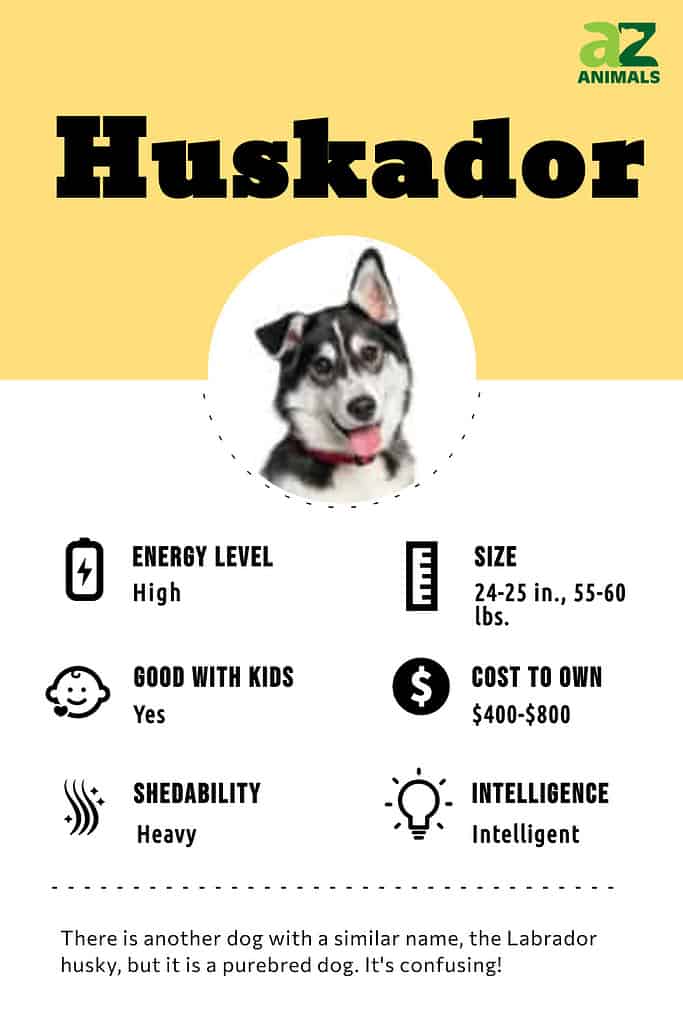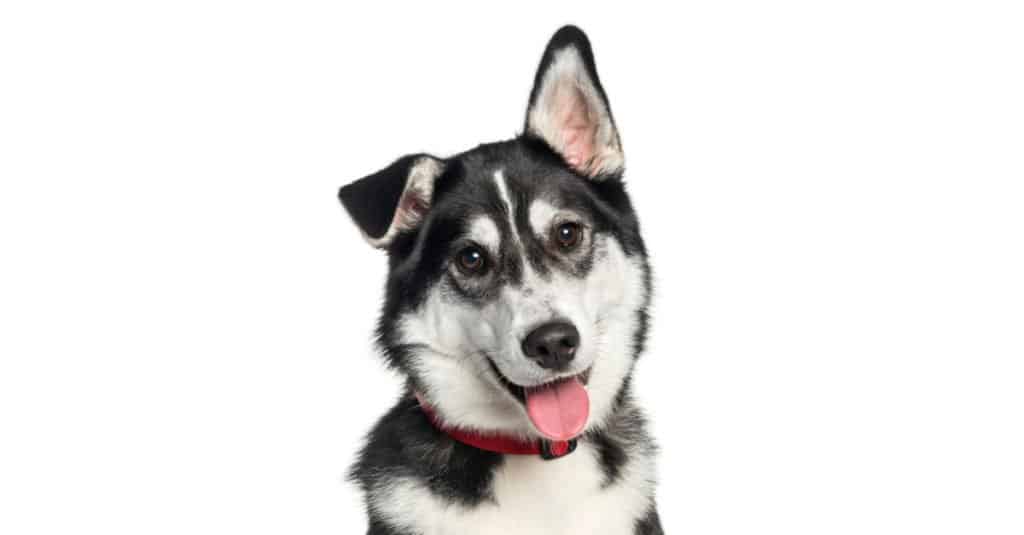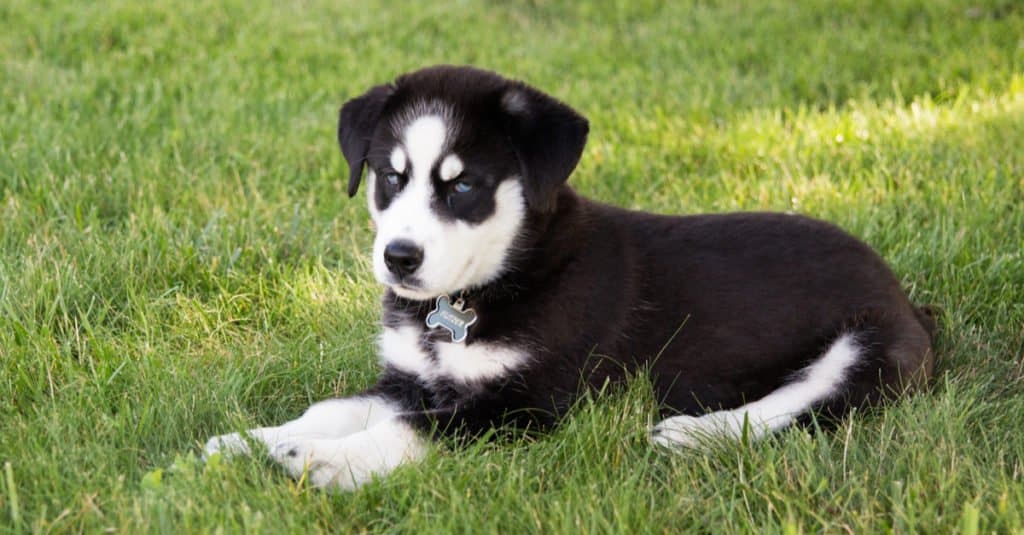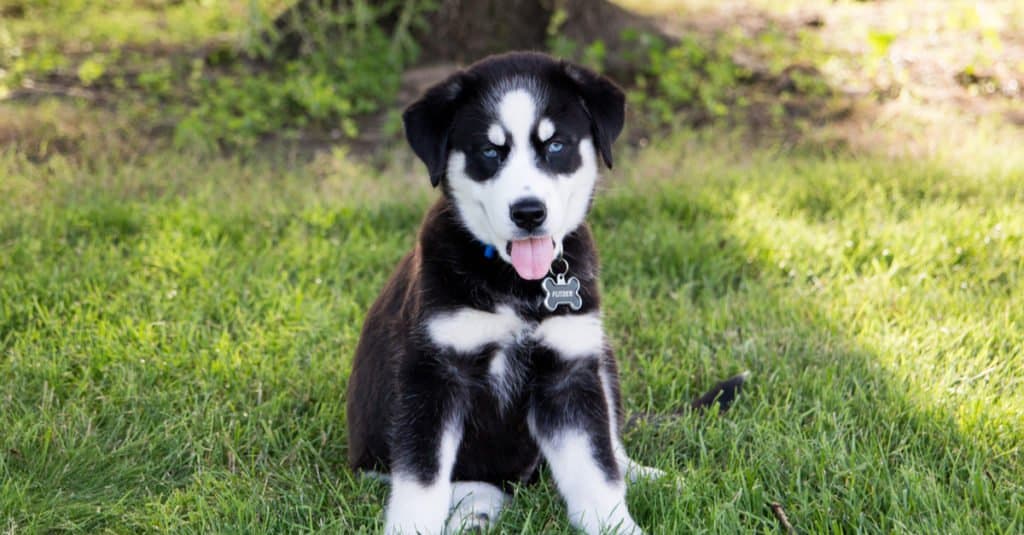Huskador (original) (raw)
Huskadors fit right into a busy household of both kids and adults. Alternatively, this hybrid breed is also right at home working as a search and rescue dog or a therapy canine.

Breed a Siberian husky with a Labrador retriever and the result is a Huskador! This dog is known for its intelligence and curious nature. Huskadors have an affectionate temperament that makes them a great pet for a family with kids.
Siberian huskies were originally bred in northeast Asia as both family pets and sled dogs, which is why they have such thick coats and high energy levels. They then gained fame and popularity as sled dogs in Alaska.
Labrador Retrievers are a gun dog breed that came from Canadian fishing dogs found in the Labrador Territory, northwest of and in Newfoundland. Known for their impressive water skills, this breed became popular among sailors and was brought to the United Kingdom in the nineteenth century. They were then bred with British hunting dogs to create what is now known as the Labrador Retriever.
A Huskador, also known as a Labsky, is a member of the hybrid group. The history of this breed only goes back about two decades. It’s thought to have originated in the United States. A Huskador has the intelligence and resiliency of a Siberian husky as well as the loyalty and affectionate nature of the Labrador retriever. A Huskador is the ultimate companion dog!
3 Pros and Cons of Ownership
| Pros | Cons |
|---|---|
| A loyal pet: Huskadors are loyal to their owners which is why they are such wonderful companion dogs. | Lots of exercise is needed: They are high-energy dogs and need at least 60 minutes of exercise each day. |
| Good with children: These dogs are affectionate and interact well with children. | A heavy shedder: This hybrid breed has a double coat which means it sheds a lot of hair. |
| Alert and ready for fun: Labskys are playful and always ready to play a game of chase or fetch with family members. | Possible challenges with training: Training a Huskador can be challenging if it has inherited more traits from its Siberian husky parent than from its Labrador parent. While Labrador retrievers are eager to please (and easy to train), Siberian huskies can have an independent streak that can make training difficult. |

Huskadors are high-energy dogs and need at least 60 minutes of exercise each day.
©Eric Isselee/Shutterstock.com
Size and Weight
The Huskador is a medium size dog with males growing as tall as 25 inches and females growing up to 24 inches. Full grown males can weigh up to 60 pounds while females weigh as much as 55 pounds. Huskador puppies weigh around 10 pounds at 9 weeks old and are considered full grown at 2 years old.
| Height (Male): | 25 inches tall |
|---|---|
| Height (Female): | 24 inches tall |
| Weight (Male): | 60 pounds, full-grown |
| Weight (Female): | 55 pounds, full-grown |
Common Health Issues
This hybrid breed shares some of the same health issues as its Siberian husky and Labrador retriever parents. One of those issues is hip dysplasia. When a dog has hip dysplasia the ball and socket of its hip joint do not fit together properly. Symptoms of this condition include limping, hopping, or a decrease in a dog’s range of motion. The treatment for hip dysplasia in Huskadors depends on the severity of the issue. Some dogs can be helped by taking supplements and reducing exercise while others need surgery.
A second health issue of Huskadors is Progressive Retinal Atrophy (PRA). This is an inherited condition that can lead to blindness. Usually, this condition doesn’t show up in dogs younger than three years old.
A third health issue is bloat. This is when a dog’s stomach expands due to trapped gas, liquid, and food. This condition cuts off blood flow to other organs which is why it’s so serious. Symptoms of bloat include retching, a distended stomach, and panting. Bloat can be prevented by feeding a Huskador three small meals a day, so it doesn’t gulp its food. Any owner who suspects bloat should take their dog to the veterinarian for immediate attention. The most common health issues in Huskadors include:
- Hip dysplasia
- Progressive Retinal Atrophy
- Bloat
Temperament and Behavior
Labskys have a friendly personality and are always up for some fun with the family. Loyalty is one of the most notable traits in this hybrid. They stay alert as to who is on the property. Although they don’t bark a lot, they’ll use their voice to let the household know that someone is at the door.

Labskys are playful and always ready to play a game of chase or fetch with family members.
©Anastasia Musikhina/Shutterstock.com
They have an affectionate behavior and always want to be where the action is happening. As a result, Huskadors can become destructive if left alone in the home for long periods of time. This is an intelligent dog with a sensitive nature.
Care
Learning as much about Huskadors as possible is helpful when determining the daily care of this pet. When it comes to exercise, diet, grooming, and health issues, taking care of a Huskador puppy is much different than taking care of an adult dog.
Best Dog Food
Huskador puppies and adults need different nutrients in their diet in order to maintain good health. Check out some factors to keep in mind:
Huskador puppy food: Protein is essential in a puppy’s diet because it supports the development of healthy muscles and tissue. Fat gives a puppy energy to run around and explore its world. Fat also contributes to keeping a Huskador puppy’s skin and double coat healthy. Calcium supports strong bone health which is especially important for a breed prone to hip dysplasia. Omega 3 fatty acids support the development of a puppy’s vision as well as its brain.
Huskador adult dog food: Lean protein is important in the diet of an adult dog. Protein supports healthy muscles, tendons, and tissue. A limited amount of fat supplies a Huskador with energy without adding weight that can lead to obesity. Obesity in these pets can contribute to the development of hip dysplasia. Fiber in an adult dog’s diet helps with digestion. Calcium is important to maintain strong bones and teeth. Fish oil supports vision and brain health in an adult dog. Feeding an adult dog three small meals per day can help to fend off bloat. Some owners place their dog’s bowl on a raised surface making it difficult for a Huskador to gulp its food.
Considering this breed’s unique dietary needs and health profile, A-Z Animals says the best dog food for Huskadors is Victor Purpose – Performance Dry Dog Food.
Not only is there glucosamine and chondroitin for clinically-proven joint support to prevent hip dysplasia, but this food cares for your Huskadors’ whole body. There’s taurine for their eyes, which are susceptible to retinal atrophy, and probiotics to ease digestion. Plus, the gluten-free high-protein recipe satiates a big appetite.
Here’s where to get Victor Purpose Performance Dog Food on amazon.
[lasso id=”422436″ link_id=”1722811″ ref=”victor-super-premium-dog-food-performance-dry-dog-food”]
Maintenance and Grooming
How much does a Huskador shed? This hybrid sheds a moderate to large amount of hair. This makes sense because this hybrid’s parents both have double coats.
The grooming routine of a Labsky should consist of daily brushing. A slicker brush helps to remove dead or loose hair from the dog’s coat. Brushing this dog each day helps to prevent tangles and mats. A grooming glove is effective when brushing this dog’s legs, face, and tail. Also, a grooming glove gives an owner more control in these sensitive areas.
Follicular dysplasia is a common skin condition of huskies and Huskadors. The signs of this condition are bare spots and dryness. There are some topical solutions and shampoos that relive the symptoms of this skin condition.
Training
Although Huskadors are a mix of two intelligent dogs, they’re sometimes challenging to train. The Labrador retriever is known as a dog that’s eager to please and therefore easy to train. Alternatively, the Siberian husky can have an independent streak that creates a challenge during training. So, the ease of training depends on whether a Huskador has inherited more traits from its Labrador parent or its husky parent!
Short training sessions and lots of praise can help any Huskador absorb all of its lessons during obedience training.
Exercise
Labskys are high-energy dogs that need at least 60 minutes of exercise each day. This is no surprise because both Labrador retrievers and Siberian huskies are highly energetic as well. Running in a field, taking a hike in the woods or playing fetch are all great ways to exercise your pet. They are good with other dogs, so taking them to visit the dog park is another good idea.
If possible, it’s best to allow your pet to run off the leash to get all of its energy out. Of course, always consider whether the situation is safe for a dog to off-leash.
This dog is not a good candidate for apartment life. Its large size would not allow it to live comfortably in an apartment. A home with a backyard would be ideal for a Huskador.
Puppies

Huskador puppies need room to run, jump, and explore in a safe way.
©Anastasia Musikhina/Shutterstock.com
Labsky puppies have almost as much energy as adults. So, it’s essential to create an outdoor environment for Labsky puppies to allow them the chance to run around, jump, sniff, and explore their surroundings in a safe way.
Children
A properly socialized dog is going to be suitable for a household with children. When a Huskador is socialized from puppyhood, it knows how to behave around both adults and children. These dogs love to run, play, and join in on any type of fun with the family.
Similar Dogs
Other dog breeds similar to this mix include Golden retrievers, Huskydoodles, and the Flat-Coated Retriever.
- Golden retriever: The Huskador and the Golden retriever share a friendly, loyal temperament, but Goldens weigh more than Huskadors.
- Huskydoodle: Huskydoodles have an intelligent, gentle temperament like Huskadors. These two husky hybrids are about the same size as well. But, Huskydoodles are low-level shedders, unlike Huskadors.
- Flat-Coated Retriever: The Flat-Coated Retriever and the Huskador are both high-energy dogs that love to play! But, the Flat-Coated Retriever is larger in size than the Huskador.
Popular Names for Huskadors
Popular names for Huskadors:
- Bear
- Athena
- Shadow
- Miska
- Ghost
- Juno
- Jax
- Echo
View all 207 animals that start with H
A Huskador, also called a Labsky, is a mix between a Siberian husky and a Labrador retriever. It’s a member of the hybrid group. This dog is smart, energetic, playful, and loves children.
The initial price of a Huskador is $600, but this varies from breeder to breeder.
The veterinary costs of this hybrid breed range from 300to300 to 300to500 per year.
The food budget for this dog is between 50and50 and 50and100 per month. This is a medium-size dog that must consume a lot of food to support its high-energy level!
Yes, a socialized Huskador is good with children. When they are socialized starting from puppyhood, they know what type of behavior is expected of them in a household.
The lifespan of this dog is 10 to 15 years.
Yes. They are loyal and love to be with their family members!